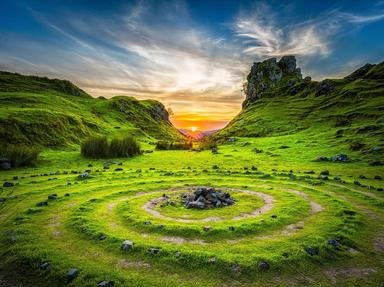Quiz Answer Key and Fun Facts
1. Niya, now a set of ruins in China's Taklamakan Desert, was once a thriving city in the second century BC. Nobody knows why the citizens deserted Niya, which was a prosperous stop along what route?
2. Catalhoyuk was inhabited almost 9000 years ago and was a site (in present day Turkey) where humans morphed from nomad to settler. What was unique about the road system in this later-abandoned city?
3. The Indus Valley Civilization, or the Harappan Civilization as it is also known, was a series of settlements in what is now western Pakistan. At its peak, in 2600 BC, it was home to over five million people before it disappeared several centuries later. They are known for having carved seals out of what material?
4. The city of Cahokia and its civilization rose around AD 700 and, at that time, was one of the largest towns ever built north of Mexico. The area was made up of over 120 earthen mounds, many of which were flat-topped pyramids and boasted a thriving metropolis. By the time Christopher Columbus set sail, this civilization had disappeared. In what modern US state was the center of their culture?
5. There stands a single monument in Afghanistan where the Hari River meets the River Jam. It is rumored to have belonged to the Ghurid Empire of the 12th century. Also called Firozkoh, what was the colorful name of the capital of this legendary empire that disappeared after a siege?
6. This lost civilization was in power in the first millennium AD and covered a huge region in the Yucatan Peninsula. Although the culture declined, their pyramids, artwork, and calendars live on. Who are they?
7. An ancient civilization in Africa, located in Nabta Playa, built an astronomical megalith that is older than Stonehenge.
8. Gobekli Tepe, a World Heritage Site in modern day Turkey, dates back to an incredible 10,000 BC. The people that gathered and lived here for hundreds of years have long vanished into history but what for what did they utilize this site?
9. Many people are familiar with the Cambodian temple called Angkor Wat. However, it is just one temple that was part of a huge civilization centered around the capital of Angkor. Of what Empire was this heavily populated city and its people?
10. The people who inhabited Easter Island, in the southeastern Pacific Ocean, are considered a lost civilization but perhaps are more famous for their Moai. What do these statues depict?
Source: Author
stephgm67
This quiz was reviewed by FunTrivia editor
ponycargirl before going online.
Any errors found in FunTrivia content are routinely corrected through our feedback system.
